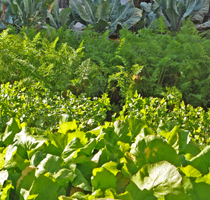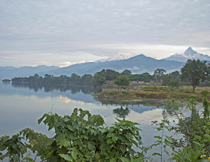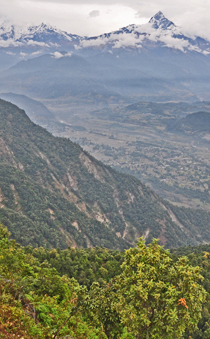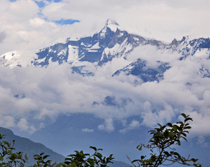November 4, 2022. Actually, it’s a 12-mile hike. But it is in Nepal. Before we hit the trail, let’s talk about eating organic in Nepal. And growing organic in Nepal.
A month after visiting my CSA farmers at their upstate New York organic farm, I visited an extraordinary organic farm in a remote Nepal village. Extraordinary because it’s a shining example of sustainability in a mostly impoverished part of the world.
Not so long ago, the farmer struggled to produce enough from a small plot to feed his family. Today, it’s a huge farm by local standards. It feeds dozens of local families. It sells its produce at market and makes a profit that’s plowed back into the farm and the community. Its organic practices make for productive, sustainable agriculture that’s a model of sustainable economics for the area.
This model farm is a long-term program of Helen Keller International (HKI). HKI’s Homestead Food Program provided seed money (literally) and technical assistance. My wife, Kathy Spahn, is HKI’s CEO. That’s how I had the opportunity to visit. And, later, to trek. Well, hike. And walk. If you’re thinking about it, the weather’s great this month.
Eating in Pokhara
This little town is the jumping-off point for most of the serious Nepal treks. It’s not a fine dining destination. But if you want to pack some local, seasonal, organic produce that’s ripe and ready, you can stop at Fishtail Organic Garden. It’s a market right on the lakeside, near every hotel, motel, hostel and boarding house. Great variety of produce; even organic honey and yak milk. Great looking carrots. Better and Cheaper. Fill your pack.
Pokhara to Sarangkot
Two miles along the shore of the beautiful Lake Phewa. Reflections of the Himalayas on the water. A flat dirt road. Two miles. 35, maybe 40 minutes.
Then onto a dirt and rock path, an old herding path. Not flat, not level. A mile through small hillside farms. It gets gradually steeper, but no huffing and puffing here. Then the path turns into a wicked steep and narrow trail. Some switchbacks, some crude steps cut into the rock centuries ago to make it possible to walk between mountain villages. You’d never find your way through this without a local guide. Ours was great.
In less than three quarters of a mile, we ascend a little more than 3,000 feet. That’s steep. An average grade of almost 45 percent. Our guide slows us down so we won’t punk out later. A 500-calorie burn and nearly an hour to climb this section to the tiny resort town of Sarangkot. Out on a ridge across a big valley from the Annapurnas.
I don’t know about you, but my jaw doesn’t actually drop all that often. Here, my jaw dropped. Every peak in sight is higher than 20,000 feet. A lot higher. You’re miles away from these mountains, but your neck’s craned up at a sharp angle so you can see the summits. If the elevation gain wasn’t breathtaking, the view is. While your mouth’s open, time for that organic snack with a view.
Sarangkot to Kaski
We descend a few hundred feet to a dirt road that takes us through a couple of miles of farming villages. Steep, terraced farming. We could be in the 16th century. Or the 12th.
Then our guide brings us back up through a small forest and back out onto the ridgeline. Parallel with the Annapurna Range. The view never stops. Five or six miles of geological magnificence. It’s really hard to keep your eyes on the trail to maintain your footing. But we stay on our feet for this 8-mile section of the hike and reach Kaski in three hours. We catch a ride back into town.
Dinner at the hotel: daal bhaat tarkari, the staple Nepalese meal. Lentil soup, rice, curried vegetables. Delicious. Here’s how to make your own. While you daydream about the mountains.
Click to see the big 3D Google Map I made for you
HKI’s Homestead Food Production programs have been improving household food enrichment and diversification for over 10 years in Nepal’s most vulnerable communities and populations. The limited availability of food with high nutrient content – and high poverty rates – contribute to higher rates of malnutrition. The program develops village model farms that in turn support almost 11,000 home gardens. You can support HKI’s work by making a donation here.




